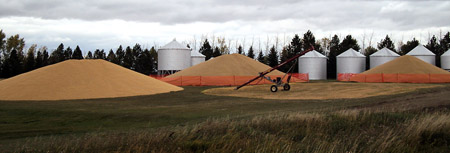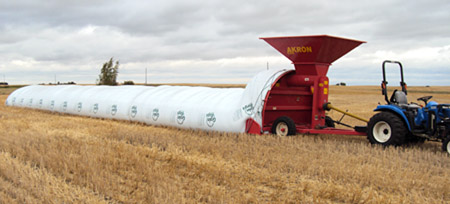Kenmare ND - Features
Real People. Real Jobs. Real Adventures.
Thanks for reading some of the latest features about area people and events.
To view every page and read every word of The Kenmare News each week,
subscribe to our ONLINE EDITION!
2009 harvest is one of extremes
The story of the 2009 harvest is a study in extremes: high yields, low prices, cool summer temperatures, a delayed frost date, and a few farmers surprised to be getting anything at all from their warm season crops.
9/30/09 (Wed)

Bins full . . . Piles of grain in farmyards have become a common sight
as bin space is in short supply.
By Caroline Downs
The story of the 2009 harvest is a study in extremes: high yields, low prices, cool summer temperatures, a delayed frost date, and a few farmers surprised to be getting anything at all from their warm season crops.
“We said we needed a great September,” said Mike Rose, NDSU Extension Agent for Ward County. “We’ve had a fabulous September. It’s helped our small grains mature, and the soybeans in southern Ward County and corn and sunflowers made phenomenal progress in September.”
Farmers have made phenomenal progress in the fields, too, since getting a delayed start in a cool growing season. Joe Peterson of SunPrairie Grain in Bowbells, reported that about 80 percent of small grains were harvested. Carl Zeltinger of Renville Elevator Company in Tolley said he was seeing about 85 percent completion, and Dan DeRouchey of Berthold Farmers Elevator estimated small grains were nearly 90 percent finished in his area.
As the crop has come off the fields, it has filled and overflowed most available storage, with yields running above average to excellent. “The wheat and durum are at 50 bushels an acre, plus,” said Zeltinger. “We’ve managed to keep some trains in here, so we’re not piling any grain. We’ve moved a large amount through.”
DeRouchey also reported steady availability of railcars. “We’re moving everything through the system,” he said. “The yields are extraordinary, some as high as 75 to 80 bushels an acre.”
Mike Rose, NDSU extension agent for Ward County, said he has seen a variety of temporary storage system used by farmers around the area, including grain bags. “And we still have a high volume crop left to harvest with the sunflowers,” he said.
Margie Herner, executive director for the Renville County FSA office, said yields were almost double the normal in her area. She mentioned one farmer who told her he was going to have to move his wheat from his bins into storage bags in order to make room for his sunflowers.
“It’s a hassle, but it’s a good hassle,” Herner said.
In Bowbells, Peterson is dealing with the largest grain pile he’s ever had at the elevator. “We have 300,000 bushels of spring wheat on the ground,” he said, “but we’re done piling now. It may be there for a month or so.”
Peterson said he knew of several producers in the area who were piling grain on their own farms for now. “It’s tough to find room for the remaining crop that’s out there,” he said. “As of Monday, we still have a little room here at the elevator, but it’s a good problem to have. There’s so much grain. I wish the prices would be better.”
Low prices confound farmers
Low prices are indeed an issue this fall, with spring wheat priced in the $4.50 to $4.85 range, durum at $4, and the situation made worse by discounts taken for low protein levels. DeRouchey noticed the reduced protein levels when the first loads were brought in a few weeks ago. “I thought it might improve as harvest went on, but it didn’t,” he said.
Rose described the low protein problem as widespread. “It’s an issue with the wheat industry statewide,” he said. “The concern is when that protein gets to the 12-13 percent range, it’s discounted quite heavily.”
According to Dan Folske, NDSU extension agent for Burke County, farmers in this region typically fertilize the ground for 40-45 bushel yields. “The crop ran out of nitrogen this year,” he said, adding that the cooler soil temperatures through the summer slowed the normal action of decomposing organic matter that releases nitrogen used by the crops.
Rose talked about the impact of the world grain supply on markets for North Dakota farmers, who recently saw more than $20 per bushel. “It’s amazing what can happen, going from record lows to a huge surplus,” he said. “We’re dealing with extremely large swings in the market. The markets blind-sided us when they went up dramatically a year and a half ago. Now, nobody predicted they would go this low.”
Soybeans, sunflower,
corn up next
Despite the low prices, the crop still has to be taken out of the fields, and attention is turning toward the warm season crops, with flax harvest about 75 percent finished in the Berthold area and getting started in the northern portions of Ward, Renville and Burke counties. “The guys I’ve talked to are happy about the [flax] yields,” said Folske. “I don’t know that it’s above average, but it’s okay.”
According to Folske, the very weather conditions that spurred on the cool season small grains--low temperatures, adequate moisture, low evaporation rates--hampered the warm season corn, sunflower and soybean production for most of the summer. “We’ve lucked out, though, and the frost has stayed away after our average date,” he said.
In fact, as of September 29th, only scarce, patchy frost had been recorded on occasion in the northwest portions of the state. “We’re going to get a crop after all,” said Folske, “and six weeks ago, nobody would have bet on that!”
Herner said Renville County farmers are expecting to harvest their sunflower acres and are holding out for their corn. “They’re hoping they don’t get a freeze, just to get a little more growing time,” she said.
Meanwhile, DeRouchey is gearing up for another round at Berthold Farmers Elevator. “The next thing on our plate is soybeans, within the next week or so,” he said. “We made it through without a frost, and they look good.”
Focus changes in the fall
The work seems to continue as even as harvest slows. Folske asked producers to take a look at their perennial weeds. “They need to be thinking about fall weed control,” he said.
Rose said some farmers will be making plans to seed their winter wheat soon, although he expects to see fewer acres dedicated to that crop this year. “Just make certain to do a good job of preparing those fields before planting,” he said.
For more information about either of these matters or other seasonal concerns, contact Rose at 701-857-6444, Folske at 701-377-2927, or LoAyne Voigt, NDSU extension agent in Renville County, at 701-756-6392.

Bagging it up . . . These grain sacks hold spring wheat and durum from Lars Christensen's fields south of Kenmare, after record yields filled his bins. This is
the first year Christensen has tried the bags, although he noted the equipment is manufactured in Argentina where the grain bags are used extensively. He likes the system and said the sacks saved the labor of one or two truck drivers
during harvest. He plans to keep this grain stored in the field until he's ready to
market it, provided deer leave the bags alone.

Abundant harvest . . . Small grain harvest yields have run above average
to excellent this fall, resulting in a storage problem for some farmers
and elevators. This grain pile at Bowbells has 300,000 bushels of spring wheat
combined within the past few days, waiting for railcars to haul it to market.

